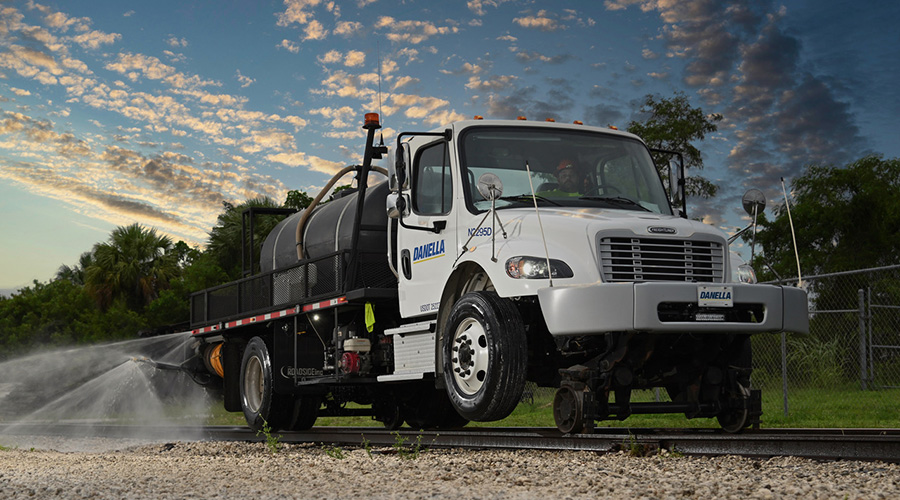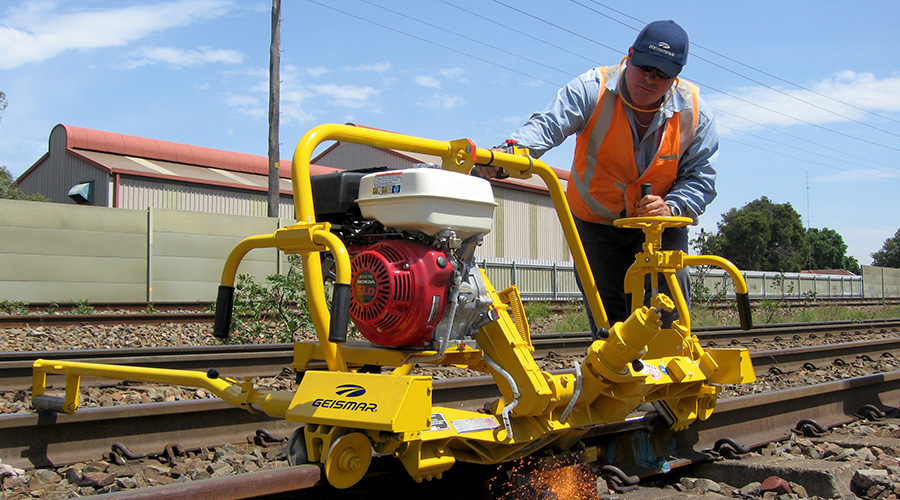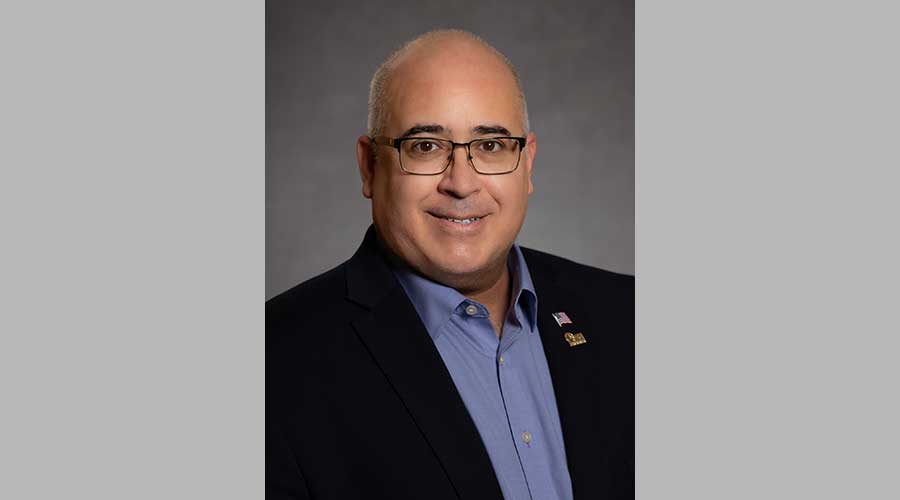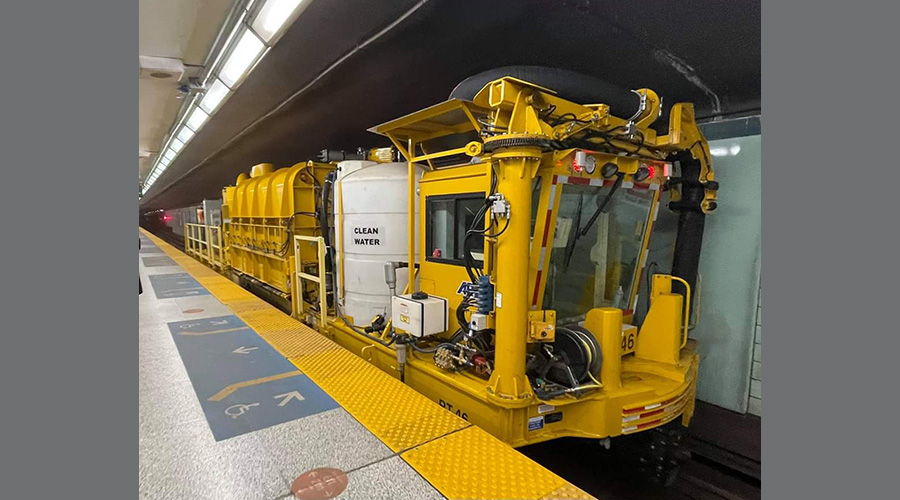Stay updated on news, articles and information for the rail industry
November 2014
Rail News: MOW
Rail grinding: Seven suppliers talk technology, techniques and trends
— compiled by Walter Weart
Rail grinding is a key tool in nearly every railroad's maintenance-of-way tool box — it can help minimize potential for derailments and extend rail life. Most railroads grind, but how they grind (and how often they do it) varies based on several factors, from geography to maintenance philosophy. Regardless, they all need the proper tools of the grinding trade. Progressive Railroading recently reached out to a cross-section of rail-grinding suppliers and service providers. We asked: Do you have information on new equipment, services or applications to share with our audience? Any grinding-related trends or developments you think need to be discussed? What are your customers clamoring for these days? Responses from seven suppliers follow.
Modern Track Machinery
Modern Track Machinery recently developed a hi-rail truck with a grinding module for the transit industry, said General Sales Manager Alan Reynolds in an email. Suited for scale removal, corrugation and rail corner grinding, the V2R-850-EMV-8T rail grinding truck can grind standard or girder rail, and features an integrated dust-collection system.
"Being a hi-rail vehicle, it allows easy access throughout the system," Reynolds said. "With our exclusively designed hi-rail system, we are also able to negotiate the sharp radius curves of the transit systems."
The grinding module is an eight-stone grinding head powered off a hi-rail truck. The module has four heads (two per side) that can be set to work independently of each other, enabling the operator to set angles to reach desired grinding positions. It also can be set on and set off quickly to accommodate short work windows.
The company is building a hi-rail unit for Honolulu Rail Transit, a passenger-rail system currently under construction in Hawaii.
"While this [unit] is being targeted to the transit industry, we also feel that there are some possible areas that would apply to the Class Is and contractors," Reynolds said, adding that more Class Is are determining they need to grind frogs and switches.
"With the cost of trackwork today, the savings [from] maintenance grinds is an easy decision," he said.
Harsco Rail
Harsco Rail is active in global heavy-haul and transit markets, and "different regions around the world are at different stages as it relates to grinding methods and expectations," said Product Manager Dereck Bartz in an email. For example, some regions are just beginning to launch grinding programs as a way to reduce defects and derailments; others have mature grinding programs and are extending rail life through gradual preventative and maintenance grinding practices. As a result, rail grinding equipment needs to be flexible, he said.
"Flexibility is beneficial so that railways may use the same machine through the progression of a long-term grinding program — maintaining consistency and reliability," Bartz added.
Some of Harsco's customers start grinding programs because they need profile correction or modification, with the aim of developing a maintenance program. Therefore, the "machines need to be aggressive as it relates to horsepower and metal removal, but then after a few grinding cycles, the machine needs the ability to adjust patterns on the fly and accurately remove only the desired amount of metal at a specific area on the rail," Bartz said. Excessive grinding can reduce rail life, so it's very important to remove only the metal that needs to be removed, he added.
As a grinding program "enters the maintenance mode," the machine needs a control system that can remove a "slight amount of metal" to maintain the desired profile while producing an acceptable surface finish, Bartz said.
While all railroads are focused on safety and operational reliability, passenger and freight roads sometimes develop grinding programs for different reasons.
"Generally speaking, transits are drawn towards grinding because of noise and vibration issues, and heavy-haul roads are generally more interested in reduction of transverse defects and rail-life extension," Bartz said.
North America and regions influenced by North American practices generally modify the rail profile to fit specific needs, he added.
"You might grind to as many as seven or eight different templates or modified profiles in a single shift for these customers, while other customers, like in Europe, will require the same template on all rails, essentially restoring the 'like new' rail profile," Bartz said.
Moreover, grinding standards can vary depending on specific market characteristics, such as type of rail, wheel profile programs, curve density, grades, traffic speeds and axle loads.
Ultimately, "active collaboration" between maintenance-of-way suppliers and railroads is critical, Bartz said. At Harsco Rail, a dedicated Intelligent Solutions group closely works with customers to help establish appropriate grinding programs. "Our company, like our competitors, is always active as it relates to R&D," Bartz said. "Safety, efficiency, reliability and life-cycle costs are the driving force for new-product development, along with environmental improvements."
Loram Maintenance of Way Inc.
Loram Maintenance of Way Inc. offers a range of rail grinding products to serve "all facets of the market," said Product Development Manager Scott Diercks in an email. "Our product depth and ability to respond to customer needs continues to drive strong product demand both domestically and globally."
Loram's product offerings include the RG400 Series — Heavy Haul, C 21/44 Series — International, RGI — International, RGS — Specialty and the L Series — Mobile/Specialty/Transit. For the heavy-haul segment, Loram offers the RG400 Series Grinder, which is used by railroads in North and South America, as well as Australia.
RG400 series grinders are designed to provide fast, safe and productive rail grinding by incorporating higher stone counts, quality assurance tools and "best in industry" grind speeds, Diercks said. The RGS grinds switches and crossings in fewer passes and can achieve speeds up to 12 mph during open rail grinding.
For specialty grinding needs, Loram's RGS enables customers to optimize productivity, reduce cost, and increase the life of switches and crossing rail, Diercks said. In markets with restrictive clearance and axle weight, the Loram RGI Series and C21/44 Series offer "the latest technology to satisfy the most restrictive precision grinding needs," he said.
"Precision grinding in many way is one of the proprietary 'secret sauce' features that allows Loram to differentiate from the competition," Diercks said. "Without going into much detail, considerable analysis is completed to identify the desired profile of the track. Then, a pre-inspection of the track is completed that identifies needs based off the target profile and rail conditions. The pre-inspection is delivered to the machine and the prescribed work is completed, optimizing both the work of the machine and the quality of the product."
As traffic density increases, railroads need to get work done as efficiently as possible, which could prompt roads to do more precision grinding, Loram officials believe.
"Less metal removed artificially through grinding leaves more of the rail head and extends the life of the rail, provided adequate metal is removed to accomplish the objective. Precision is required to ensure this is the case," Diercks said. "Less metal removal required allows even faster speeds, fewer passes, less time spent in a block and a lower cost per track mile. Speeds will continue to be limited by the need to provide precise profiling of the rail as well as line of sight requirements for machine operation."
Meanwhile, product development continues as Loram works with customers to identify enhancements and innovations, the most recent of which have centered on the integration of grind management and quality assurance to extend rail life and reduce overall maintenance costs, Diercks said.
As rail grinding practices and technology continue to evolve, Loram will continue to work with customers to evaluate grinding practices in an effort to move from a corrective grinding model to a preventative grinding model — the latter focuses on profile and surface condition restoration before the rail wears to the point where a greater amount needs to be removed, Diercks said. The idea: Preventative grinding increases grinding efficiency by allowing an increase in grinding speed with fewer grinding passes to achieve desired results.
Also part of Loram's suite of technology and equipment: Rail Inspection Vehicle (RIV) services for measuring track quality, and developing and implementing an accurate grind plan. RIVs collect rail profile and surface condition data to monitor quality and develop a grind plan by determining optimal passes, patterns and speeds for the rail grinder to ensure the right profile will be achieved.
Some users of grinding equipment such as transit operators have unique needs that are met by equipment designed specifically for that application.
In addition to serving North America, Loram recently delivered two RGI grinders to Deutsche Bahn in Germany and sold three new grinders to Network Rail in the United Kingdom.
"Loram will continue to focus on expanding its reach internationally, and offering technology and equipment that has performed well in North America for many decades," Diercks said.
Racine Railroad Products Inc.
Racine Railroad Products makes an array of hydraulic and gasoline hand grinding tools. The company's Stand-Up Web Grinder has been "very successful" in alleviating back strain because it enables operators to grind in a standing position rather than having to bend over, said Sales and Product Support Manager Steven Ries in an email.
"We also have had success improving our spark guards on our gas utility grinder to better direct spark patterns away from the operator," he added.
Racine Railroad Products also offers a frog and switch grinder designed to resurface frogs and switch points to their original specifications, allowing longer product life and requiring less maintenance compared with hand grinding methods, Ries said.
Because railroads continually search for ways to prevent brush fires caused by sparks from grinders and rail saws, Racine Railroad Products recently enhanced its rail saws to "better direct the spark pattern to reduce this hazard," Ries said.
More efficient hydraulic fluid heat dispersal can prolong the life of hydraulic grinding tools; when the fluid overheats, tool seals can deteriorate and "significantly shorten" a tool's lifespan, Ries said. To better prevent fluid overheating, Racine Railroad Products introduced the Trak Pak II Hydraulic Power Unit, which utilizes an electric thermostatically controlled cooling fan that moves more airflow through the oil cooler, increasing cooling efficiency. The company incorporated a nine-gallon hydraulic reservoir that allows a larger volume of fluid to be utilized, reducing overheating occurrences, Ries said.
Plasser American Corp.
Plasser American Corp.'s GWM Rail Grinding Machines are designed for grinding tracks and turnouts.
"Noise is an important issue with transit systems. Plasser has addressed this issue by utilizing a special method of rail rectification — acoustic grinding using oscillating grinding stones," company officials said in an email. "This method achieves an immediate reduction of the noise. The decisive factor is not by what amount the emission is lowered, but to which level it can be lowered."
The grinding process is achieved through the back-and-forth oscillating movement of the grinding units (six grinding stones per unit) and the continuous forward motion of the machine. The vertical load can be adjusted hydraulically, and a water spraying unit ensures a dust- and spark-free work process while grinding the rails. The result: a high-grinding output and an optimum rail surface quality that "contributes substantially" toward noise reduction, the company said.
This method of rail rectification also can be described as "acoustic grinding," according to Plasser.
"Many years of experience have shown that when using [our GWM] oscillating action grinding machine, it is possible to produce the lowest acoustic level of the rail running surface, which is a great advantage on railway lines that run through residential areas," the company said. "It has been shown that noise levels have been reduced up to 12 decibels."
Beyond regular rail-surface maintenance work, another grinding application "has come to light," as Plasser officials put it: the treatment of new rails.
"In various long-term studies carried out by several railway administrations, it was seen that when preventative grinding is performed on the rail surface, corrugations occur far later than on untreated new rails," the company said. "The reason for this is the removal of the initial roughness that occurs during manufacturing."
The smoothing of rusted surfaces of new rails using a GWM grinding machine also includes the fine grinding of the welded areas. Grinding work should be carried out after laying and welding the new rails, even before the first trains begin running over it, the company said.
Plasser offers a variety of self-propelled, hydraulically powered machines with up to five grinding units per rail, each carrying six oscillating grinding stones that adapt to the rail profile and "always apply the correct (hydraulically adjustable) vertical load to the rails," the company said.
Vossloh Rail Services North America
Vossloh Rail Services North America recently introduced new grinding technology for the transit realm: the HSG-city unit. It's currently being used on an in-road tram system in Germany to ensure the noise mitigation is achieved per local rules, said Vossloh Rail Services America Vice President and General Manager Ron Martin in an email.
"They've had problems in the past with noise, and this is the solution that best fits their needs," he said. "The system fits very well with their maintenance scheduling, as well, with the unit being able to operate at speeds up to 35 mph. This is a purely preventive measure that helps maintain the correct profile the rail should stay in."
In terms of grinding-related trends, Martin said: "The railroads are getting closer and closer to their goal of only doing maintenance grinding, at least in theory. The problem is that as traffic increases, the availability of track time is getting less and less. This, in turn, does not allow the roads to maintain what they have achieved in the last few years as they were catching up on their corrective programs. This is going to start the cycle all over again in rail deterioration."
And the speed of grinding "is and always will be" an issue, he added.
"With the present technology, it will be almost impossible for them to maintain their plant to the level they would like. Other more advanced technologies will need to be considered in the near future to meet the demands of the rail maintenance schedules."
Meanwhile, railroads will continue to ask for improvements — to systems, procedures and product quality.
"The most consistent request is for an increase in speed," Martin reiterated. "Any metal removal process is limited to the amount of metal it removes per pass — if too much metal is attempted to be removed during grinding, you get a negative heating effect on the rail. The actual working speed of a unit is in direct relation to the amount of metal being removed.
This isn't the only reason railroads consider using rail milling technology.
"The amount of track time required to produce a specific number of rail feet to be corrected should be the measurement considered," Martin said. "The actual working speed of milling is relatively close when you look at the number of passes required and the amount of metal to be removed. The more metal to remove, the more sense milling makes due to its high per-pass removal rate. Add that the milling can work any time of year in any conditions and almost anywhere ... and you realize the completed work timeline dictates the amount of track time required."
A milling system — Vossloh plans to have one available in the North American market by spring 2015 — also is the most environmentally friendly option: It doesn't generate grinding dust, create sparks or leave other waste material behind, Martin said.
"Add the Eddy-current testing, which is done pre-mill and post-mill for validation of the successful removal of any rail flaws, and you have the most up-to-date rail maintenance management systems available now and in the foreseeable future," he said.
Railtech Matweld Inc.
New developments with welding processes always have created the need for custom-designed solutions in the grinding realm, said Railtech Matweld Inc. Vice President of Sales and Marketing Alex Hellkamp in an email.
"The Head Wash Repair Weld that has been developed and brought to the industry by Railtech Boutet is a prime example," he added. "The Head Wash Weld Repair Weld removes defects from the ball of the rail with minimal disturbance to the track. The targeting of a defect and weld repairing it requires grinding out the defect zone precisely from the ball of the rail. The process requires a controlled width and that depth be ground out."
The company's lightweight, ergonomically designed Head Wash Grinder permits "just such precision," Hellkamp said, adding that the company was instrumental in helping grinding stone manufacturers develop, test and approve a product to suit this grinder. This type of collaboration will continue "in our fast-paced industry," he said.
Preventing back strain and operator fatigue is key, and Railtech Matweld designs grinders with ergonomics in mind, Hellkamp said.
"Our profile and multi-purpose grinders, used in combination, permit the grinding of rail welds while maintaining an upright standing position for the operator," he said. "Traditional grinding of the rail web and base with a hand-held grinder is becoming a thing of the past."
Meanwhile, the company's Precision Frog Grinder is designed to preserve rail, switch and frog life.
"[The] ability to target the area precisely and grind while standing upright keeps operators out of the harmful grinding dust while preserving their back and preventing fatigue," Hellkamp said. "You can mill with this grinder in precise movements. Operators can now remain clear of harmful grinding dust when grinding out a defect in the frog, as well as in profiling the weld repair installed."
Ultimately, the Precision Frog Grinder affords "consistent, repeatable grinding results," which is particularly important considering there are so many new hires in the rail industry, he added.
Walter Weart is a Denver-based freelance writer. Email comments or questions to prograil@tradepress.com.


 LRW Honors Amtrak’s Acheson As Railway Woman Of The Year
LRW Honors Amtrak’s Acheson As Railway Woman Of The Year
 From Editor-In-Chief Foran: Of Gender Equity And Inclusion
From Editor-In-Chief Foran: Of Gender Equity And Inclusion
 Spotlight On Some Of Today’s Rail Safety Products
Spotlight On Some Of Today’s Rail Safety Products
 Women of Influence in Rail eBook
Women of Influence in Rail eBook
 railPrime
railPrime







